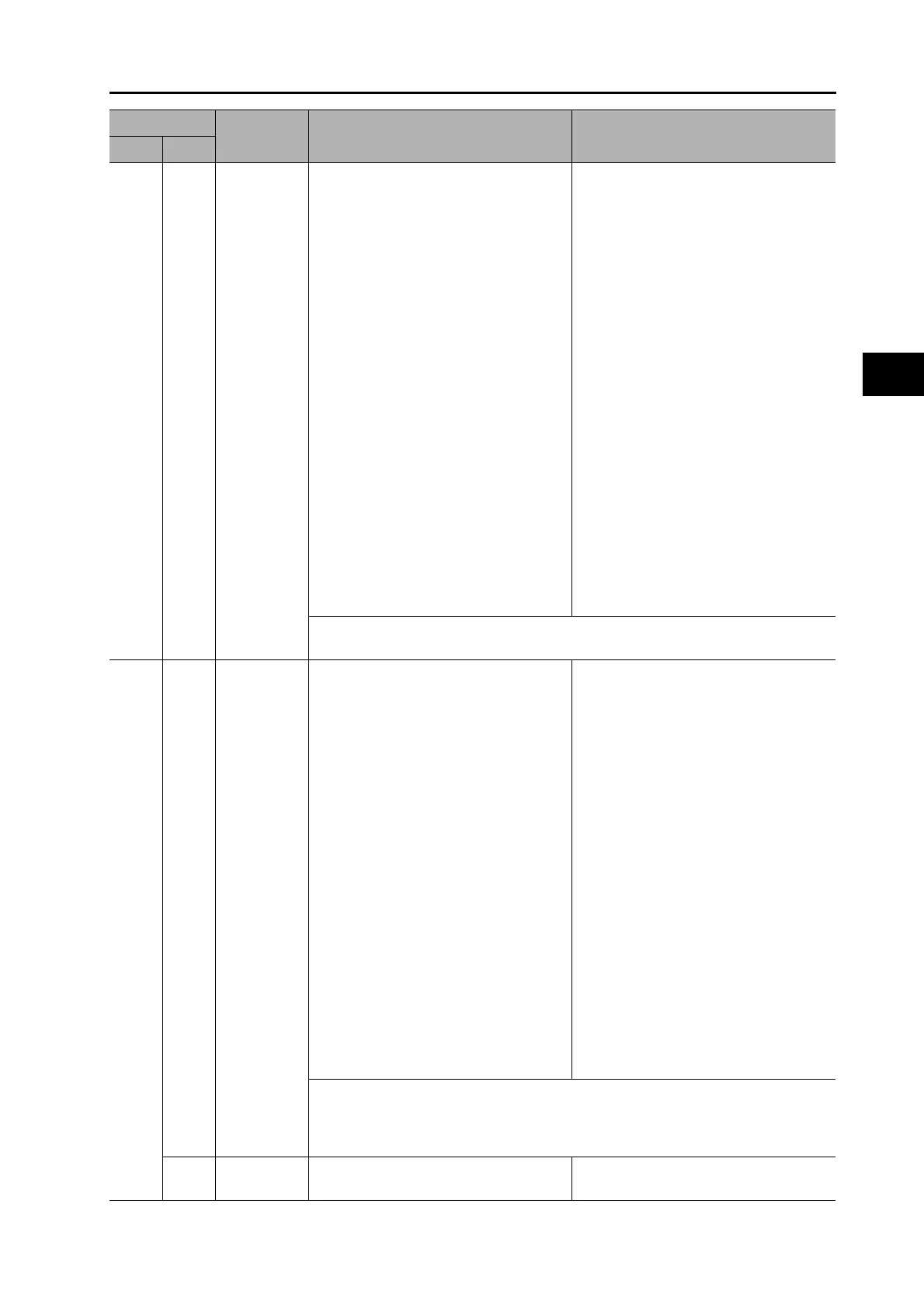12-16
12-4 Troubleshooting
OMNUC G5-series AC Servomotors and Servo Drives User’s Manual (with Built-in EtherCAT Communications)
12
Troubleshooting and Maintenance
16 0
Overload When the feedback value for torque
command exceeds the overload level
specified in the Overload Detection Level
Setting (3512 hex), overload protection is
performed according to the overload
characteristics.
• The load was heavy, the effective torque
exceeded the rated torque, and
operation continued too long.
• Vibration or hunting occurred due to
faulty gain adjustment. The Servomotor
vibrates or makes unusual noise. The
Inertia Ratio (3004 hex) setting is faulty.
• The Servomotor wiring is incorrect or
broken.
• The machine was hit by an object, or the
machine load suddenly became heavy.
The machine was distorted.
• The electromagnetic brake remains ON.
• When multiple machines were wired, the
wiring was incorrect and the Servomotor
cable to was connected to a Servomotor
for another axis.
Check if torque (current) waveforms
oscillate or excessively oscillates
vertically during analog output or
communications. Check the overload
warning display and the load rate through
communications.
• Increase the capacities of the Servo
Drive and the Servomotor. Set longer
acceleration and deceleration times.
Reduce the load.
• Readjust the gain.
• Connect the Servomotor cable as
shown in the wiring diagram. Replace
the cable.
• Remove the distortion from the
machine. Reduce the load.
• Measure the voltage at the brake
terminals. Turn OFF the brake.
• Wire the Servomotor and the encoder
correctly so that the wiring matches the
axes.
Refer to 3-2 Overload Characteristics (Electronic Thermal Function) on page 3-31 for
information on overload characteristics.
18
0
Regeneration
Overload
The regenerative energy exceeds the
processing capacity of the Regeneration
Resistor.
• The regenerative energy during
deceleration caused by a large load
inertia increased the converter voltage,
and then insufficient energy absorption
by the Regeneration Resistor further
increased the voltage.
• The Servomotor rotation speed is too
high to absorb the regenerative energy
within the specified deceleration time.
• The operating limit of the external
resistor is limited to a 10% duty.
Check the load rate of the Regeneration
Resistor through communications. This
Regeneration Resistor cannot be used for
continuous regenerative braking.
• Check the operation pattern (speed
monitor). Check the load rate of the
Regeneration Resistor and check for the
excessive regeneration warning display.
Increase the capacities of the Servo
Drive and the Servomotor, and length
the deceleration time. Use an External
Regeneration Resistor.
• Check the operation pattern (speed
monitor). Check the load rate of the
Regeneration Resistor and the
excessive regeneration warning display.
Increase the capacities of the Servo
Drive and the Servomotor, and lengthen
the deceleration time. Reduce the
Servomotor rotation speed. Use an
External Regeneration Resistor.
• Set the Regeneration Resistor Selection
(3016 hex) to 2.
Precautions for Correct Use
Always provide a temperature fuse or other protective measure when setting the
External Regeneration Resistor Setting (3017 hex) to 2. Otherwise, the Regeneration
Resistor will not be protected, generate excessive heat, and be burnt.
1
Regeneration
Tr Error
The Servo Drive regeneration drive Tr is
faulty.
Replace the Servo Drive.
Error No. (hex)
Name Cause Measures
Main Sub

